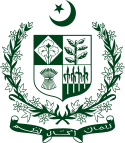Muslim League (Pakistan)
Muslim League مسلم لیگ ( Green | |
|---|---|
| Party flag | |
 | |
 |
|---|
|
|
The Muslim League was the original successor of the
History

On the
Ideology
The party remained the chief governing party for the early years after the partition. Under the premiership of
The party's economic policies were pro-Capitalist. Prime Ministers like Khan and Bogra were keen supporters of a Western-style economy and promoted
End of party
Jinnah died in September 1948 and Liaquat was assassinated in October 1951. Robbed of its two senior leaders, the League began to disintegrate. By 1953, dissensions within the League had led to the formation of several different political parties. Liaquat was succeeded by Khawaja Nazimuddin, a Bengali, who was forced out of office in April 1953. Pakistan was racked by riots, and in the first national elections in May 1955 (held by a system of indirect voting) the League was heavily defeated.
In October 1958, the Army seized power and the martial law regime of Muhammad Ayub Khan banned all political parties. This was the end of the old Muslim League.
Other parties by the same name
The name still held great prestige, however, and Ayub Khan later formed a new party, the
heavily won the ballot underAfter 1971, in Pakistan (West) the PPP led by Zulfiqar Ali Bhutto took power. In 1977 Bhutto was removed by General Ziaul Haq through a coup. After the death of Pakistan's military ruler and later civilian President Muhammad Zia-ul-Haq in 1988, a new Muslim League was formed under the leadership of Nawaz Sharif, but it had no connection with the original Muslim League. Sharif was prime minister from 1990 to 1993 and again from 1997 to 1999, when he was ousted in Pakistan's third military coup. At the controversial elections held by the military regime of Pervez Musharraf in October, five different parties using the name Muslim League contested seats. The largest of these, the Pakistan Muslim League (Quaid-e-Azam), won 69 seats out of 272, and the Pakistan Muslim League (Nawaz), loyal to Nawaz Sharif, won 19 seats. After the elections in 2008, Quaid-e-Azam league was in the ruling coalition and the Nawaz Sharif's Muslim League sat in opposition. In the 2013 elections, Pakistan Muslim League (Nawaz) emerged as the largest party in the country; the party formed its government at the center and Nawaz Sharif was re elected for third term as Prime Minister of Pakistan.
Current factions of re founded party
References
- ^ "Atheist Fundamentalists". The Times of India.
- dawn.com. Retrieved 21 November 2020.
- ^ "The Muslim League | Islamopedia Online". Archived from the original on 4 March 2016. Retrieved 29 April 2013.


